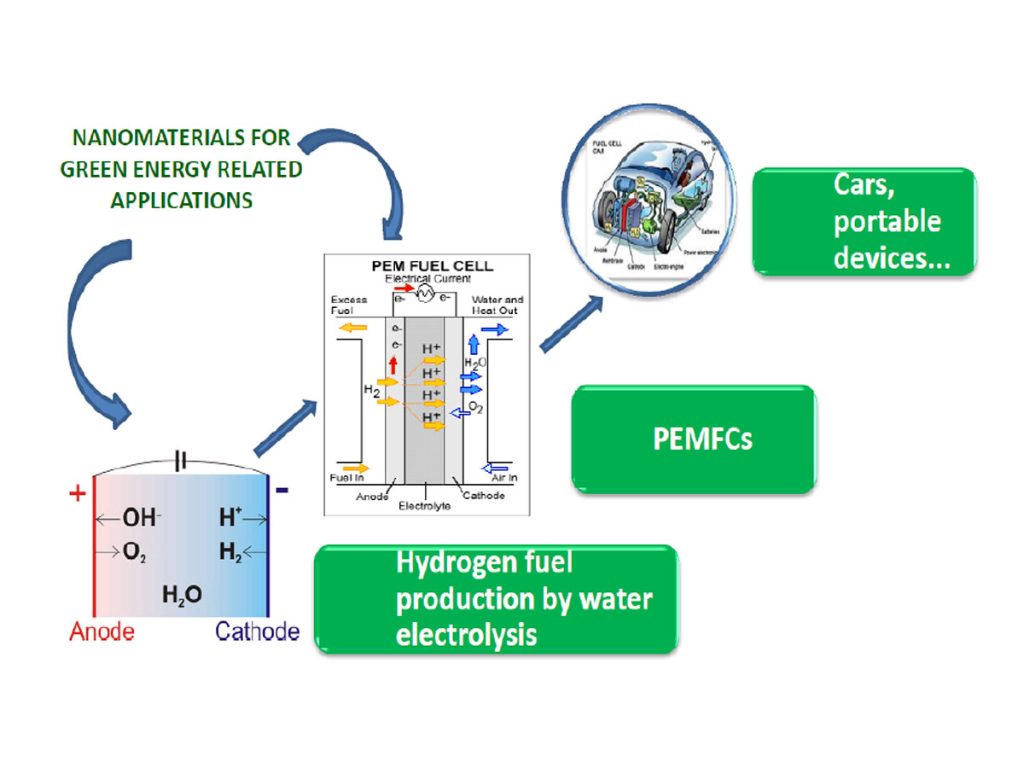Renewable energy
Hydrogen energy based society
The main contemporary industrial processes are based on fossil fuel usage. The reserves of these fuels are estimated to be exhausted during several next centuries. It demands intensive progress in alternative power sources development. On the other hand fossil fuel application leads to the growing environment pollution, causing the so called “greenhouse effect”. Namely, during the last century the CO2 concentration increased about 20%, being the main reason for average temperature increase on Earth. This fact has already caused undesirable climate changes, connected to animal and plants biodiversity disorder.
United Nations (Republic of Serbia is a member) has recognized environment pollution effects and global actions to prevent it have already been taken. From Stockholm conference held in 1972, Kyoto in 1997 to Paris Climate Agreement 2015 United Nations announced several declarations (Declaration of the United Nations Conference on the Human Environment), to stabilize gas emission and decrease greenhouse effect. European Union has established main targets until 2050, in the frame of Climate and Energy Package, to increase alternative power sources usage and save environment.
Hydrogen is considered as a pure, high efficiency and environmental friendly fuel. It is usually produced by gas or oil decomposition (or fossil fuels derivates), in nuclear plants, or by biomass degradation. However, the pure hydrogen can be obtained by water electrolysis, relatively easy and well established industrial procedure, commonly processed in alkaline 30% KOH solution, at 80oC, with nickel based electrodes. The main disadvantage of this process is still relatively high energy consumption per m3 of obtained hydrogen (~ 5kWh m-3 H2). Thus, to give water electrolysis great perspectives in the future commercial applications, development of novel higher activity and stability catalysts is needed. The hydrogen produced by water electrolysis can be used as fuel in low temperature fuel cells, while common applied oxidative agent is oxygen from air, or pure oxygen gas. Many researchers’ efforts were done to make progress in these two fields during past several decades. However, there is still place to improve existing and introduce novel catalysts preparations procedures, to achieve higher efficiency and long term stability, to lower costs and increase life time of these devices.

Several members of Center of Excellence for Green Technologies (bolded names in reference list) have been involved in water electrolysis and low temperature fuel cells investigations during several decades.
Relevant projects:
- Project of bilateral collaboration between Republic Serbia and Germany, 2020-2021, “TiO2 nanotube arrays decorated with platinum group metal nanoparticles for electrocatalysis applications”.
- “Development, characterization and application nanostructured and composite electrocatalysts and interactive supports for fuel cells and water electrolysis” (Ministry of Education, Science and Technological Development Republic of Serbia,(2011-2019).
- COST MP1407, “Electrochemical processing methodologies and corrosion protection for device and systems miniaturization” (European cooperation in science and technology, supported by the EU Framework Programme Horizon 2020; 2015-2019).
- Project of bilateral collaboration between Republic Serbia and Slovenia, 451-03-3095/2014-09/26, ” Synthesis and characterization of Pt nanocatalysts at metal oxide based supports for fuel cells application“, (2014-2015);
- “Synthesis, characterization and application catalysts on the basis of nanoparticles at different supports, in fuel cells, water electrolysis and electro organic synthesis“ (Ministry for Science Republic of Serbia, ( 2006-2010);
- “Electrocatalysts on the basis of intermetalic compounds and special alloys for hydrogen evolution, hydrogen oxidation and hydrogen absorption reactions” (Ministry for Science and Environment Protection, Serbia and Montenegro, 2000-2005)
- Project Marie Curie, MSCF-CT-2004-516594, “Micro and Nano Deposition– – MINDE” (2005-2009)
Recent selected publications:
Elezović N. R., Zabinski P., Lačnjevac U. Č., Krstajić Pajić M. N., Jović V. D.(2021), Electrochemical deposition and characterization of iridium oxide films on Ti2AlC support for oxygen evolution reaction, Journal of Solid State Electrochemistry, Vol.25, 351–363(2021). IF za 2019=2.646 (14/27, ELECTROCHEMISTRY)
Elezovic N.R., Brankovic G., Zabinski P., Marzec M., Jovic V.D. (2020), Ultra-thin layers of iridium electrodeposited on Ti2AlC support as cost effective catalysts for hydrogen production by water electrolysis, J. Electroanalytical Chemistry 878: 114575, IF(2019)=3.807, 17/81, CHEMISTRY ANALYTICAL
Lačnjevac U., Vasilić R., Dobrota A., Đurđić S., Tomanec O., Zbořil R., Mohajernia S., Nguyen N. T., Skorodumova N., Manojlović D., Elezović N, Pašti I., Schmuki P., (2020), High-Performance Hydrogen Evolution Electrocatalysis Using Proton-Intercalated TiO2 Nanotube Arrays as Interactive Supports for Ir Nanoparticles”, Journal of Materials Chemistry A, accepted October 7th 2020. IF(2020)=12.732 (8/114, ENERGY & FUELS).
Elezovic N.R., Lovic J.D., Jovic B.M., Zabinski P., Włoch G., Jovic V.D. (2019), Synthesis and characterization of AgPd alloy coatings as beneficial catalysts for low temperature fuel cells application, Electrochimica Acta, 307: 360-368, IF(2019)=6.215 (5/26, ELECTROCHEMISTRY).
Lačnjevac U., Vasilić R, Tokarski T., Cios G., Żabiński P., Elezović N., Krstajić N. (2018), Deposition of Pd nanoparticles on the walls of cathodically hydrogenated TiO2 nanotube arrays via galvanic displacement: A novel route to produce exceptionally active and durable composite electrocatalysts for cost-effective hydrogen evolution, Nano Energy, 47: 527–538 IF=15.548 (za 2018) (8/94 NANOSCIENCE & NANOTECHNOLOGY).
Lovic J.D., Elezovic N.R., Jovic B.M., Zabinski P., Gajic-Krstajic Lj., Jovic V.D.(2018), Electrodeposited AgPd alloy coatings as efficient catalysts for the ethanol oxidation reaction, International Journal of Hydrogen Energy, 43:18498-18508, IF(2019)= 4.939, 24/97 Energy and Fuels).
Jović V.D., Jović B.M., Lačnjevac U.Č., Krstajić N.V, Zabinski P., Elezović N.R. (2018), Accelerated service life test of electrodeposited NiSn alloys as bifunctional catalysts for alkaline water electrolysis under industrial operating conditions, Journal of Electroanalytical Chemistry IF(2016)=3.012 (20/76, CHEMISTRY, ANALYTICAL)
https://doi.org/10.1016/j.jelechem.2017.06.011





